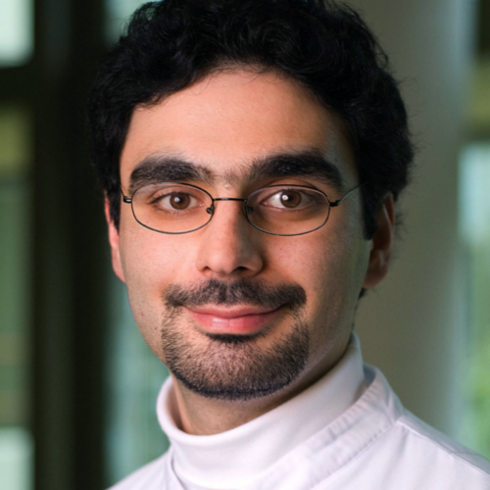CP Neuroendocrine
Expertise
The Neuroendocrine Oncology Program is a highly collaborative program devoted to bringing cutting-edge treatments to our patients. Although neuroendocrine neoplasms (NENs) are still rare diseases, we have more than 600 patient visits per year in our outpatient center– one factor contributing to the high patient accrual is the fact that the surgical department is the largest pancreatic cancer center in Europe continuously improving its operating techniques within multicenter trials (Diener, Lancet 2011).
A second factor is the close collaboration of our neuroendocrine tumor experts from gastrointestinal Surgery, Pathology, Endocrinology, Nuclear Medicine, Interventional Radiology, Gastronenterology and Radiation Oncology. The team selects the appropriate treatment plan within specialized tumor board meetings twice a week. Starting PRRT in 2003 with 100-150 Dotatoc therapies/year and radioembolisation since 2009 with up to 75 SIRT therapies/year we are one of the most experienced centers in Germany offering these new treatment options for NET patients in clinical routine and clinical investigations. In translational research we have shown that Chromogranin A fragments are able to regulate metastatic small intestinal NEN proliferation via the AKT pathway indicating that CgA plays a far more complex role in the biology of these tumors than previously considered (Giovinazzo /Schimmack, PLOS ONE). With respect to clinical trials we started to be successful in participating in multicenter RCTs in order to offer our patients new treatment options: e.g. a RCT multicenter trial testing the effect of telotristat etiprate, an orally-delivered small molecule that acts by inhibiting the enzyme tryptophan hydroxylase (TPH) to control symptoms in functional carcinoids.
Coordinators
- Department of Internal Medicine (Endocrinology)
- Department of Nuclear Medicine (Radiology)
- Department of Surgery
- Department of internal Medicine (Gastroenterology)
- Institute of Pathology
- NCT, Dept. of Medical Oncology
- Dept. of Diagnostic Radiology
- NCT Social Services
- Radioembolisation (SIRT),
- Radioiodine-Metomidate-therapy of cortical adrenal tumors
- Peptide Receptor Radiation Therapy (PRRT / DOTATOC)
- DOTATOC-PET/CT (carcinoids and isle cell tumors),
- DOPA-PET/CT (katecholaminergic tumors, medullar thyreoid cancer),
- Exendin-4-PET/CT (insulinomas),
- MIBG-SPECT/CT (pehochromocytoma/neuroblastoma) regularly for clinical routine
- Integrated innovative treatment options for patients with neuroendocrine tumors into clinical routine: such as Radioembolisation (SIRT), MIBG-therapy of malignant pheochromocytoma/neuroblastoma, Radioiodine-Metomidate-therapy of cortical adrenal tumors and Peptide Receptor Radiation Therapy (PRRT / DOTATOC)
- A collaboration agreement with the European governmental institution: European Commission - Joint Research Centre – Institute for Transuranium Elements (EC, JRC, ITU) in Karlsruhe, to improve PRRT of neuroendocrine tumors by optimizing the radionuclide that can be tagged to somatostatin analogs. First results have already been honored by two Young Investigator Awards, one from the Society for Nuclear Medicine (SNM), one from the Radiologic Society of North America (RSNA) and one “Picture of the year” from SNM/JNM.
- Established a hybrid-imaging group (nuclear medicine, diagnostic radiology) to make combined morphological and molecular imaging of neuroendocrine tumors routinely available. We already offer DOTATOC-PET/CT (carcinoids and isle cell tumors), DOPA-PET/CT (katecholaminergic tumors, medullar thyreoid cancer), Exendin-4-PET/CT (insulinomas), Metomidate PET/CT (corticoadrenal tumors), MIBG-SPECT/CT (pehochromocytoma/neuroblastoma) regularly for clinical routine - to our knowledge this is currently the widest spectrum of neuroendocrine related PET-tracers offered by a single imaging center.
- Established research collaboration with Gastrointestinal Pathobiology Research Group, Yale University School of Medicine, New Haven, USA that is working on diagnostic improvement in the detection of metastasis as well as understanding the molecular pathways driving tumor proliferation.
- Investigation of additional biomarkers (like internexin alpha) for prognostic and particularly predictive use
- Molecular characterization of pancreatic neuroendocrine neoplasms and better understanding of tumor proliferation and metastasis, especially in G1 pNETs.
- Better understand the role of Chromogranin A in the regulation of cell proliferation
- Further improve and evaluate interventional treatment options (like arterial application of Dotatoc-therapy) in patients with hepatic metastasis
- Initiation of new phase I/II studies based on the results from translational research
- Expand the clinical trials program to offer new treatments to our patients








